
Helvetia In House Movements
Helvetia developed and manufactured their own high quality in-house movements for many years.
Scroll down for more.....
Helvetia developed and used its own movements from its very start up to the late 1960s when it began to use ETA movements. Helvetia also used its own patent shock protection system for its watches before adopting the widespread Incabloc system in the 1950s. Helvetia’s own movements were high quality and innovative for their time.
To start I’ll take a minute to explain the way Helvetia classified their movements. First of all was a calibre (or design) number; say 82 or 800, then if there were small changes they added a version letter; A, B, C etc. And lastly if they changed the layout of bridges and plates on the top of the movement they added a suffix; -24. So one of their most commonly used movements was called the 82A-24. Not all calibre numbers used all of the variations, for instance Calibre 800 movements only came in 800C and 800D. The introduction of new layouts of bridges and plates didn't necessarily mean that the old ones were discontinued either, the Calibre 82A movement continued as 82A-24 for many years after the introduction of the -28 and -32 configurations.
I am not an expert on wristwatch movements and what follows is not a technical appraisal of each movement but rather a discussion of the main features, rough dates of introduction and discontinuance and the use Helvetia made of each movement. I have, more or less, listed the movements in chronological order of the date they were in use below. I believe the information to be correct but most of it is gleaned from observation only and there is not much to go on so I would welcome any further insight anyone might have!
Trench Watch Movement
This movement was used in General Watch Co 'Trench' Watches from roughly 1914 to 1918. It appears to have just been known as the Helvetia 13 Ligne movement. From 1919 to the mid 1920s a new Helvetia movement was used based on the AS 137 movement but with the bridges altered to resemble the earlier Helvetia 13'" movement.

Helvetia 13'" from 1915
.jpg)
Helvetia 13'" (AS 137) 1924
Calibre 51
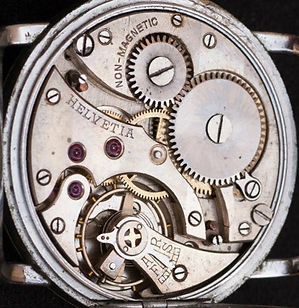.jpg)
Calibre 51S Movement
_edited.jpg)
The calibre 51 movement was a movement which was developed for use in wristwatches by having the crown moved to the 3 o’clock position and the sub seconds dial at the 6 oclock. This is called a savonette configuration.
Calibre 51-10 Movement
The movement seems to have come in two versions, there was the earlier 51S that was in use up to about 1934 and was fitted with the Depollier/Brun type shock protection. This was then superseded by the 51-10 that was fitted with Helvetia's own anti-shock system. The calibre 51 was commonly used in Helvetia's larger pilot’s watches and I have seen it used in watches whose serial numbers date them from about 1932 through to the mid 1940s. It is a 16 Ligne movement (about 36mm).
Calibre 80 Family
The calibre 80 family of movements was the mainstay of Helvetia, in use from 1929 through to the 1960s. Standard thinking (and logic) dictates that the calibre 80 was the first of these movements and the others were adapted from this, however I have not been able to find any evidence of calibre 80 watches before the introduction of the 80C in the late 1940s.
Calibre 81 and 82 (10.5 Ligne, about 23mm) are movements with a sub second dial. The 81 seems to have appeared in 1929 and the 82 10 years later in the late 1930s. The only real difference I can see between them is the positioning of the dial feet and screws.
Calibre 81
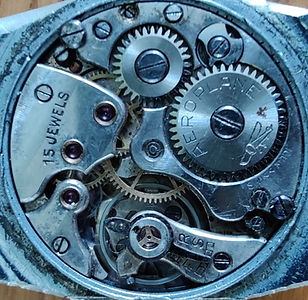
Calibre 81-20 Movement
_edited.jpg)

Calibre 81-24 Movement

Calibre 81-26 Movement
The Calibre 81/82 had a long life with Helvetia over several different bridge configurations; -20, -24, -26, -28, from the 1920s through to the mid 1940s.
A lot of the early movements are inscribed “Patent Shock Absorber” and it may be that the “A” suffix refers to the fitting of this shock protection but as Helvetia didn’t mark all of their early movements with the calibre number it is difficult to say for sure. What I can say is that the calibre 81 and 82 movements that I have seen (apart from some of the very latest 82C-32 movements which have Incabloc) are fitted with Helvetia’s own anti-shock system.
Calibre 81-28 Movement
Calibre 82
_edited.jpg)
Calibre 82A-24 Movement
_edited.jpg)
Calibre 82A-28 Movement
The 82A, manufactured from the late 1930s, was almost exclusively used in military style watches including those provided to the German army.
The 82B was apparently a larger version of the 82A at 11.5 Ligne (about 26mm} but I have never seen an example of one.
The calibre 82C was introduced in the mid 1940s and had an improved setting lever, shock protection, and crown wheel. This better quality movement was used for dress watches with only a few fitted in military style watches with luminous hands and dials. The 82C continued in use into the 1960s. I have seen an 82D referred to in movement catalogues but have not seen any examples of these movements.
_edited.jpg)
Calibre 82C-24 Movement
_edited.jpg)
Calibre 82C-28 Movement
_edited.jpg)
Calibre 82C-32 Movement
Calibre 820
_edited.jpg)
During the late 1930s Helvetia began to introduce watches with central seconds rather than having seconds displayed separately in a sub dial. Initially it looks as if they adapted their calibre 81 movement with an indirectly driven central second hand and used it in some of their sports watches. Then in about 1940 Helvetia introduced the calibre 820 which was a centre seconds version of the 82A. The adaption for a central second hand made the 820 about 25% thicker than the 82A at 4.95mm. The 820 movement is relatively rare and I have only seen it in a few military style Helvetia watches and some watches Helvetia made for Helbros both dating from 1943.
Adapted Calibre 81-28
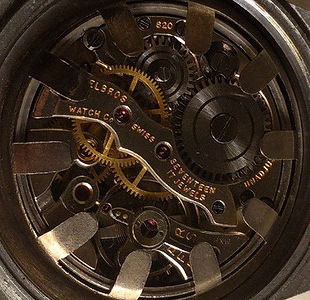_edited.jpg)
Calibre 820-24 Movement
_edited.jpg)
Larger Calibre 820B-32 Movement
_edited.jpg)
Calibre 820C-32 Movement
This was followed by the 820B which, continuing the tradition of the 82B being a larger version of the 82A, was a larger version of the 820 and was fitted with an improved crown wheel. The 820C introduced the improved setting lever and shock protection to the 820 in the late 1940s and the 820D followed with with a new, simpler, form of regulator. All of the 820 series seem to have been fitted to military style watches.
Calibre 80
In the mid 1940s Helvetia decided to introduce a larger 11.5 Ligne sub seconds movement for their dress watches, alongside the smaller 82C, called the 80C. The 80C carried on in use for Helvetia’s dress watches through to the 1960s.
I have found no evidence for earlier 80, 80A or 80B versions. If anyone has seen any please let me know but I am assuming that as they did not introduce this movement until they had already inroduced the improvements of the C variant to their other movements there was no need to manufacture inferior versions and so went straight to the 80C.
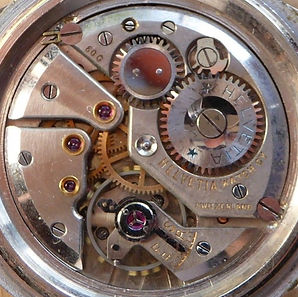_edited.jpg)
Calibre 80C Movement
Calibre 800
_edited.jpg)
Calibre 800C Movement
_edited.jpg)
Calibre 800D Movement
Also introduced in the mid 1940s was the 800C a centre seconds version of the 80C. This seems to be the same as the 11.5 Ligne 820B with the improvements of the “C” variant added.
It looks to have been used equally for dress and military style watches.
It was in use up to the early 1950s and there is an 800D variant with simplified shock protection that seems to have been introduced in the late 1940s.
Calibre 80 Family Variations (A, B, C, D)
As outlined above as well as different bridge configurations (-20, -24, -26, -28, -32), the 80 family of movements also went through a number of variants that introduced improvements to different movement parts. Below is a visual summary of the main differences.
Crown Wheel

81
82A
820
_edited_edited.jpg)
82C
820B
820C
820D
80C
800C
800D
Base Plate Shock Protection

81
82A
820
820B
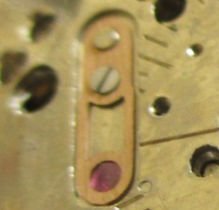
82C
820C
820D
80C
800C
800D
Setting Lever

81
82A
820
820B
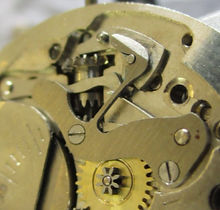
82C
820C
820D
80C
800C
800D
There where also a number of differences to the upper shock protection and regulator but these don't necessarily follow the variant letters but seem to be introduced as they were developed. However by the time the C variant was introduced the shock protection was all of the later type and the main difference for the D variant seems to be a simpler method for attaching the shock protecting spring.

'C' Variant
Shock
Protection
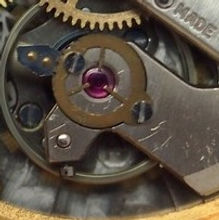
'D' Variant
Shock
Protection
Calibre 830, 836-838, 844-845
As the 1950s began Helvetia brought in a whole new family of movements to replace the 80 family which had served since the 1920s. The advent of this family of watches also spelled then end for Helvetia’s own patent shock protection with the Incabloc system becoming standard on almost all of their movements from now on. The first of this new family was the 830 which seems to have been a replacement for the 800C, as a 11.5 Ligne centre seconds movement, but thinner and with a more reliable directly driven second hand.
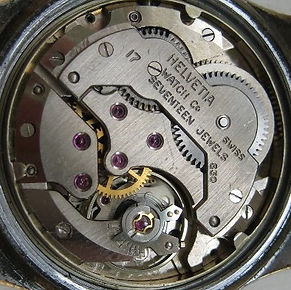_edited.jpg)
Calibre 830 Movement
_edited.jpg)
Calibre 836 Movement
It was soon followed in the 1950s by the 836, 837 and 838 automatic versions and later on by the 844 and 845 (date and non-date automatics) which had additional Kif-Duofix combined shock protection for the escapement wheel in addition to the standard Incabloc shock protection.
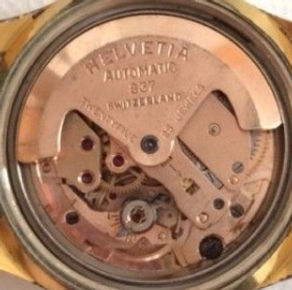
Calibre 837 Movement
_edited.jpg)
Calibre 838 Movement

Calibre 845 Movement
Calibre 831 & 834
While the 830 family carried on as automatics it looks as if Helvetia decided to replace the 830 manual wind movement and the 831 and 834 (non-date and date) were introduced. They were thinner again at under 4mm and had the gears redesigned to provide a simpler, more efficient, directly driven centre second hand. They also had Girocap shock protection for the escapement wheel as well as Incabloc. I have not seen many of these movements and the ones I have seen date from the 1960s.
_edited.jpg)
Calibre 831 Movement

Calibre 834 Movement
Calibre 64 & 68
_edited.jpg)
Calibre 64 Movement
_edited.jpg)
Shortly after the introduction of the 830 family, in about 1960, Helvetia also introduced the calibre 64. This was a large 13.5 Ligne movement, reflecting the trend for larger watches at this time, though thinner than the 82C it replaced. It was in use right through to the late 1960s. There was also updated versions; the 65 & 68. Some of these movement also had the addition of Kif-Duofix combined shock protection for the escapement wheel.
Calibre 68 Movement
The calibre 64 may be based on the Unitas 6310 movement and superficially is very similar looking though it has a lot of differences including a different hand setting mechanism and different hand sizes. The calibre 65 and 68 do resemble Unitas movements much more closely however and interestingly do not have a Helvetia movement mark under the balance wheel unlike the calibre 64.
This was the end of the road for Helvetia's own movements and by the late 1960s they were using ETA manufactured movements in their watches.
I have tried to cover most of the main movements Helvetia developed above but I have not covered everything, there are the 75A rectangular movements and 90A smaller 8.75 Ligne movements for instance. Due to time and space constraints I’ve left them out for now. As stated before the above information is correct to the best of my knowledge but please feel free to add your own comments below.
Some of the close up images of differences between Calibre 81/82 versions above with thanks to watchguy.co.uk
.
.
